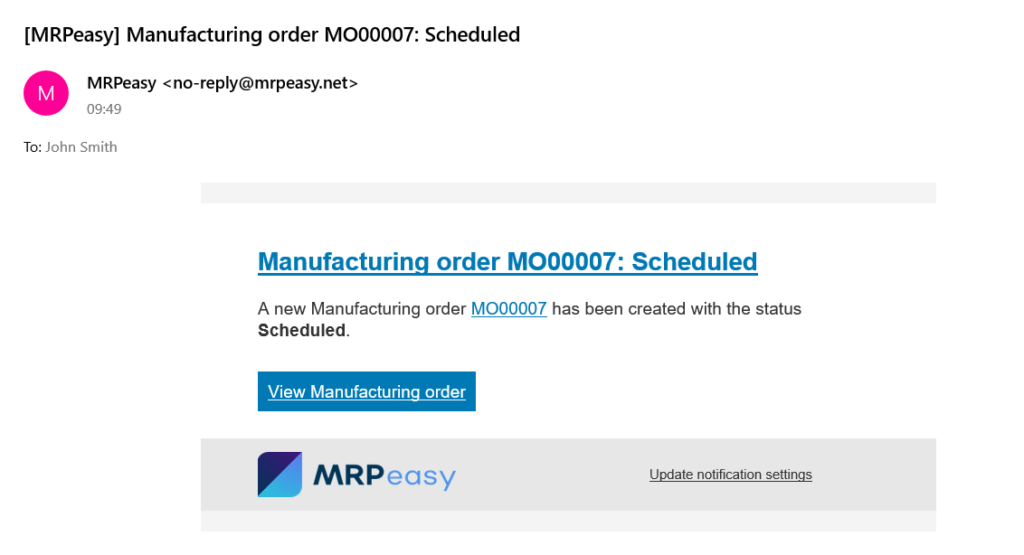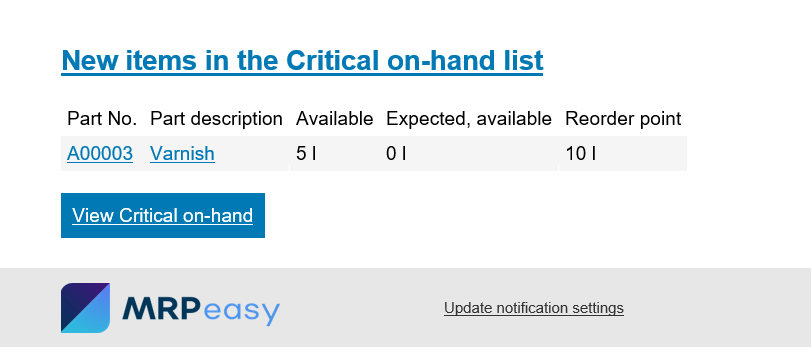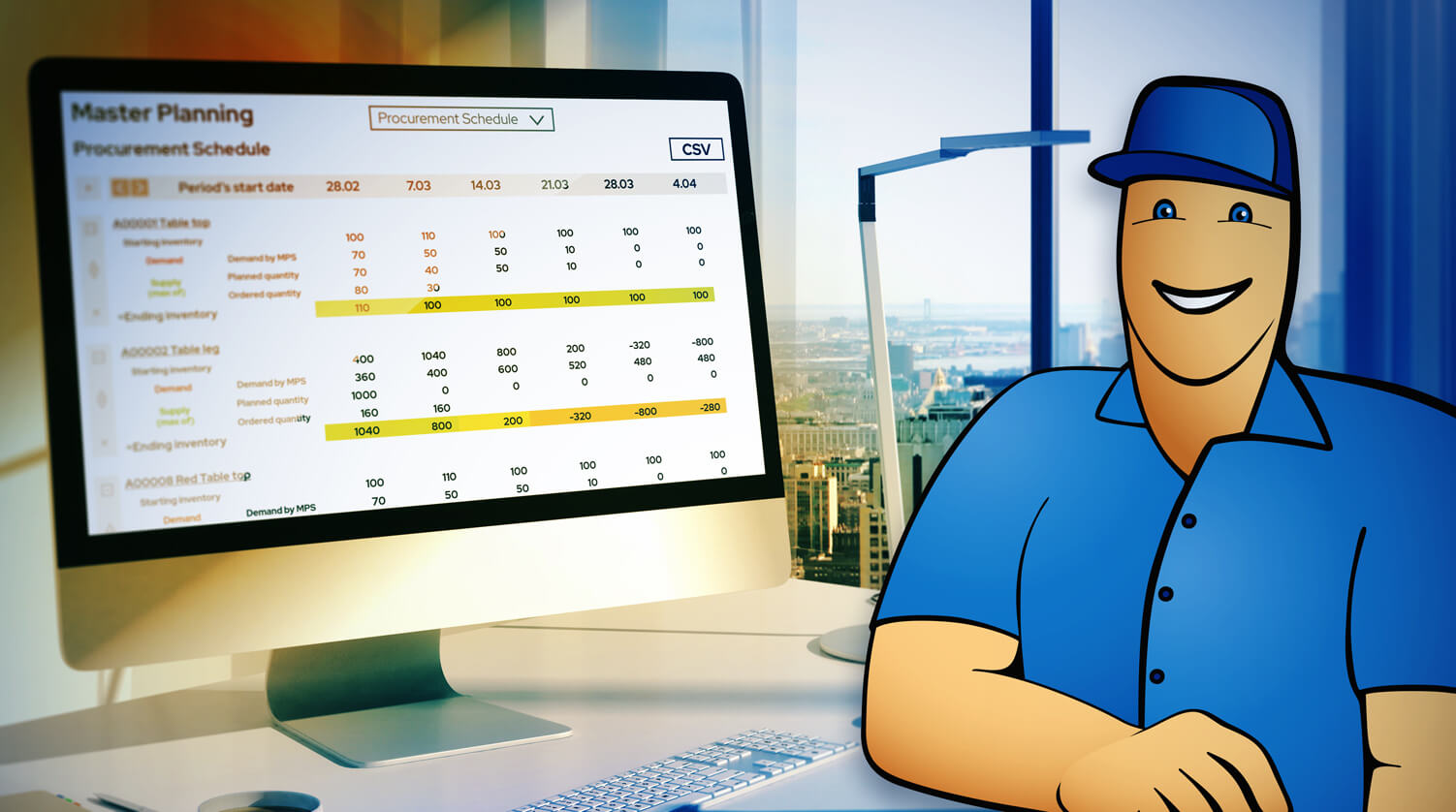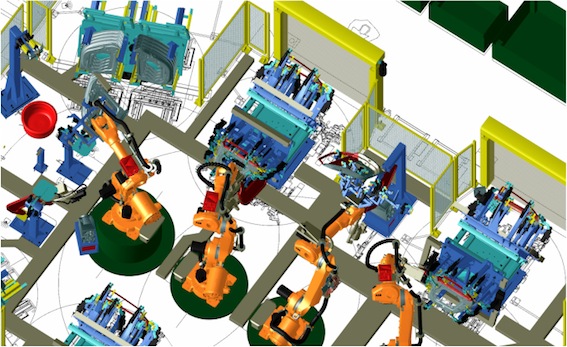Low Stock Alerts and other Manufacturing and Inventory Notifications
Even with an ERP/MRP system in place, it might be difficult to keep tabs on inventory requirements, production plans, and other important areas of the business. This is where low stock alerts and other manufacturing and inventory notifications come to your aid.

Why are notifications necessary?
Even though an ERP system is a huge step forward in inventory tracking and manufacturing management, without someone constantly checking the data in the software, things can sometimes be overlooked. For example, a new unforeseen task can be left unnoticed, low inventory levels can be left unattended, and the maintenance schedule of machinery disregarded.
This is where notifications come into play. Depending on the software and user settings, software notifications can alert the necessary parties of low inventory levels, due dates, changes in the data, etc. For example, when a portion of a raw material SKU is consumed so that its count drops below the reorder point, a message is sent to the inventory manager and/or any other person responsible for the replenishment of stock. This way, companies can minimize downtime caused by slow communication and become more efficient in the long run.
But not all ERP/MRP systems offer notifications. That means in order to minimize the chances of overlooking some critical aspects of your business, you should make sure to choose one that supports them.
Types of software notifications
There are various ways different solution providers offer alerts and notifications. For one, software providers can utilize different types of delivery systems for getting the notifications to your screen, but the subject of the alerts can obviously differ, as well.
Types of delivery systems
The types of delivery systems used by ERP/MRP providers can vary as much as those used by other apps or websites. From push notifications to text messages and e-mails, your provider has to find a way to deliver alerts efficiently, and without being too annoying.
Push notifications
Push notifications are alerts sent to the user’s computer or smart device without the application itself being open, just like apps such as Messenger can instantly notify you when someone sends you a message.
Messenger notifications
Some software providers have opted for messenger notifications for conveying important messages to users. Software user accounts are tied to a messenger app account (such as Facebook Messenger, Whatsapp, etc.) so that alerts are sent via the third-party app. For some employees, however, using their personal messenger accounts for work might conflict with their need for privacy.
Text message notifications
Text message notifications are sent directly to the phone number tied to the user account. This could be a little bit too intrusive because text messages cannot be turned off without turning off the device. That is why companies that work in shifts rarely want to use this type of notifications as they could disturb employees on their time off.
E-mail notifications
E-mail notifications are messages sent to the e-mail address tied to the user account. These can be considered the least intrusive notifications because they are most often tied with employees’ work e-mail addresses, not their personal accounts. After work, incoming e-mail notifications can be turned off from the e-mail account settings so that they would not bother employees during their personal time. This is the method of notification delivery used also by MRPeasy.

Types of notifications
Like everything else in a manufacturing business, notifications have to be optimally allocated. That means every single event does not merit a notification, but there are some that are more important than others. For example, here are the notifications that MRPeasy users can subscribe to.
Low stock alerts
Often considered the most important notification type, the low stock alert (or critical on-hand notification) can be a tremendous contribution to the uninterrupted workflow of the whole company. If insufficient inventory levels are overlooked, especially when it comes to materials critical for production, the whole operation could come to a screeching halt. That is why low stock alerts are frequently a deciding factor when companies are choosing an ERP/MRP system.
Approval request notifications
If your company relies on the Approval system functionality in your ERP to establish a checkpoint before an order can be processed further, these notifications should come in very handy. When a new MO or PO is created, a notification is instantly sent to the user in charge of approving documents. This way, order approvals can be expedited, making the business again a little more efficient.
Personal schedule notifications
Alerts related to employees’ personal schedules can be a great aid, as well. For example, a worker’s weekly production schedule can be sent to them one hour before the start of the business week. Likewise, when a new task is assigned to a worker, they would be made aware of it without delay.
Order status notifications
Tracking changes to the statuses of customer orders, manufacturing orders, or purchase orders is an essential part of keeping tabs on the progress made in the business. With a number of different markers from quotation to delivery, new MO to MO finished, or from new PO to PO received, an order status notification system makes tracking the progress of orders effortless.
Maintenance notifications
With an integrated maintenance management system in place, an ERP/MRP system can keep count of when a machine or a workstation needs to be serviced. For example, when a set number of parts have been processed (or a set number of days passed) since the last maintenance, the system sends a notification to the user responsible for machinery upkeep.
Key takeaways
- Because important things can sometimes be overlooked even with a well-implemented ERP solution, software notifications can be an additional support system that would reinforce efficient communication in the company.
- By using an ERP/MRP system that supports notifications and alerts, companies can minimize downtime caused by slow communication and become more efficient in the long run.
- Different software providers use different media to offer alerts and notifications. These range from push notifications to text messages, from third-party messenger apps to e-mail notifications.
- Push and e-mail notifications can be considered the least intrusive of the aforementioned delivery systems as they can be easily turned off after the workday.
- Some notification types that manufacturers and distributors can benefit from are low stock alerts, approval request notifications, personal schedule notifications, order status notifications, and maintenance alerts.
You may also like: Top 10 Manufacturing KPIs in 2022





